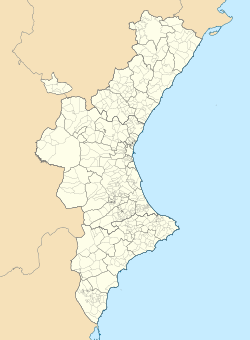
Back Valencia, Spanje AF Valencia ALS ቫለንሲያ AM Valencia AN بلنسية Arabic ڤالينسيا ARZ València AST Valencia AY Valensiya AZ والنسیا AZB
Valencia
València (Valencian) | |
|---|---|
|
| |
 Location of Valencia | |
| Coordinates: 39°28′12″N 00°22′35″W / 39.47000°N 0.37639°W | |
| Country | |
| Autonomous Community | Valencian Community |
| Province | Valencia |
| Comarca | Horta of Valencia |
| Founded | 138 BC |
| Districts | 19 districtes
|
| Government | |
| • Type | Ayuntamiento/Ajuntament |
| • Body | Ajuntament de València |
| • Mayor | María José Catalá (since 2023) (PP) |
| Area | |
| • Municipality | 134.65 km2 (51.99 sq mi) |
| • Urban | 628.81 km2 (242.78 sq mi) |
| Elevation | 15 m (49 ft) |
| Population (2023)[4] | |
| • Municipality | 807,693[1] |
| • Density | 5,998.5/km2 (15,536/sq mi) |
| • Urban | 1,595,000[3] |
| • Metro | 2,522,383[2] |
| Demonym(s) | Valencian •valencià, -ana (va) •valenciano, -na (es) |
| GDP | |
| • Metro | €56.413 billion (2020) |
| Time zone | UTC+01:00 (CET (GMT)) |
| • Summer (DST) | UTC+02:00 (CEST (GMT)) |
| Postcode | 46000-46080 |
| ISO 3166-2 | ES-V |
| Website | www.valencia.es |
Valencia (Spanish: [baˈlenθja] ⓘ, officially in Valencian: València [vaˈlensia])[a] is the capital of the autonomous community of Valencia and the third-most populated municipality in Spain, with 807,693 inhabitants (2023).[1] It is the capital of the province of the same name. The wider urban area comprising the neighbouring municipalities has a population of around 1.6 million,[3][6] constituting one of the major urban areas on the European side of the Mediterranean Sea. It is located on the banks of the Turia, on the east coast of the Iberian Peninsula at the Gulf of Valencia, north of the Albufera lagoon.
Valencia was founded as a Roman colony in 138 BC under the name Valentía Edetanorum. After the fall of the Western Roman Empire, Valencia became part of the Visigothic Kingdom from 546 AC and 711 AC.[7] Islamic rule and acculturation ensued in the 8th century, together with the introduction of new irrigation systems and crops. Aragonese Christian conquest took place in 1238, and so the city became the capital of the Kingdom of Valencia. The city's population thrived in the 15th century, owing to trade with the rest of the Iberian Peninsula, Italian ports, and other Mediterranean locations, becoming one of the largest European cities by the end of the century. Already harmed by the emergence of the Atlantic World trade in detriment to Mediterranean trade in global trade networks, along with insecurity created by Barbary piracy throughout the 16th century, the city's economic activity experienced a crisis upon the expulsion of the Moriscos in 1609. The city became a major silk manufacturing centre in the 18th century. During the Spanish Civil War, the city served as the accidental seat of the Spanish Government from 1936 to 1937.[8]
The Port of Valencia is the 5th-busiest container port in Europe and the second busiest container port on the Mediterranean Sea. The city is ranked as a Gamma-level global city by the Globalization and World Cities Research Network.[9] Its historic centre is one of the largest in Spain, spanning approximately 169 hectares (420 acres).[10] Due to its long history, Valencia has numerous celebrations and traditions, such as the Falles (or Fallas), which was declared a Fiesta of National Tourist Interest of Spain in 1965[11] and an intangible cultural heritage by UNESCO in November 2016. In 2022, the city was voted the world's top destination for expatriates, based on criteria such as quality of life and affordability.[12][13] The city was selected as the European Capital of Sport 2011, the World Design Capital 2022 and the European Green Capital 2024.
- ^ a b "Valencia/València población por municipios y sexo. Instituto Nacional de Estadística. Retrieved 18 March 2024.
- ^ Cite error: The named reference
MetroRegionwas invoked but never defined (see the help page). - ^ a b Cite error: The named reference
WorldUrbanAreaswas invoked but never defined (see the help page). - ^ Municipal Register of Spain 2018. National Statistics Institute.
- ^ "Gross domestic product (GDP) at current market prices by metropolitan regions". ec.europa.eu.
- ^ Cite error: The named reference
MdFdEwas invoked but never defined (see the help page). - ^ "Valentia (138 a.c. - 711) | Museu d'Història de València". mhv.valencia.es. Retrieved 20 April 2024.
- ^ "History of Valencia". whc.unesco.org. Retrieved 13 June 2023.
- ^ Cite error: The named reference
GAWCwas invoked but never defined (see the help page). - ^ "Districte 1. Ciutat Vella" (PDF). Oficina d'Estadística. Ajuntament de València (in Catalan and Spanish). 2008. Archived from the original (PDF) on 5 April 2010. Retrieved 16 February 2010.
- ^ Conselleria de turisme de la Comunitat Valenciana, ed. (2010). "Listado de Fiestas de Interés Turístico de La Comunitat Valenciana Declaradas Por La Conselleria de Turisme" (PDF). Retrieved 11 April 2011.[permanent dead link]
- ^ "Valencia named top city for expats". The Independent. 5 December 2022. Archived from the original on 30 January 2023. Retrieved 30 January 2023.
- ^ Liu, Jennifer (December 2022). "This Spanish city is the No. 1 place to live and work abroad―and it's about to get easier to become a digital nomad there". CNBC. Archived from the original on 30 January 2023. Retrieved 30 January 2023.
Cite error: There are <ref group=lower-alpha> tags or {{efn}} templates on this page, but the references will not show without a {{reflist|group=lower-alpha}} template or {{notelist}} template (see the help page).








